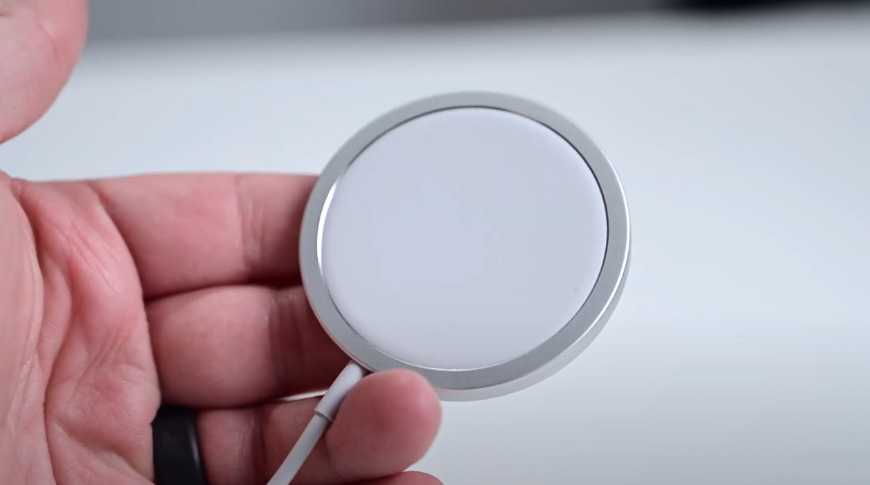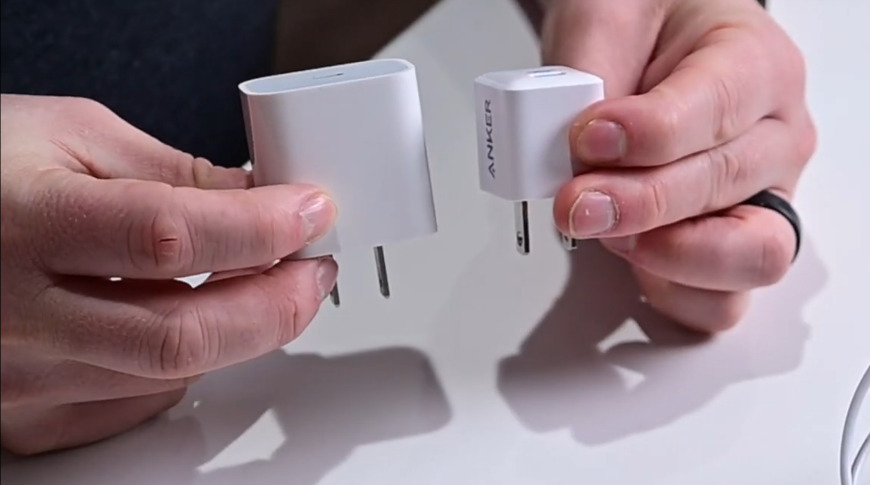If you want to charge your iPhone 12 using MagSafe, Apple recommends using certain 20W AC adapters — and they don't need to come from Apple, despite what you may have heard. We explain what the requirements are, and why an older 18W adapter just won't cut it.
Apple released the iPhone 12 lineup with an all-new accessory and charging system called MagSafe. The name was previously used to refer to a magnetic quick-release cable for Apple's portable Mac line, but had since been lost when Apple shifted to USB-C.
What is MagSafe?
MagSafe in this case, refers to the magnetic capability of the accessories more so than the safety the accessories provide like it did prior. One accessory released is the MagSafe Charger, which is a large charging puck that attaches to the rear of the iPhone 12 for wireless charging. Unlike other wireless chargers, it magnetically grips the iPhone when in use which means you can pick up and use the iPhone while charging.
The large surface area coupled with Apple's own proprietary design allows for up to 15W of delivered power to a device when charging when using the MagSafe charger vs only 7.5W on Qi chargers. The ability to charge at twice the speed of Qi is a major benefit to using MagSafe, but it does come with some caveats.
Buckle up. This is going to get a little more technical than we normally get. If this stops you from reading further, here's the takeaway: if you don't want to buy Apple's USB-C AC adapter, any USB-PD 3.0 one with equivalent specs will do to get that faster charging speed, and a lesser one, won't.
USB-C Power Delivery
USB PD is a specification for handling higher power on USB and allows a range of devices to charge quickly over a USB connection. It facilitates negotiation between two devices so they can determine how much power can be pulled from the charger. Power Delivery offers multiple power profiles from 5V to 20V, including a crucial 2.22 amp power profile. More on this in a bit.
The USB PD 3.0 spec was released in mid 2019 and the rollout of the technology takes time. Adapters purchased before 2020 may not have the spec, and thus, will not and cannot meet the charging requirements for MagSafe. Apple chose this spec for a reason, it is a more intelligent standard that understands more about the device it is charging.
A USB PD 2.0 device would negotiate power based on power requirements alone. The USB PD 3.0 spec allows the adapter to gain more information from the device while charging, like temperature and charging malfunction.
The USB PD 3.0 spec also includes more intelligence for controlling amperage and voltage while charging. When adjusting voltage or amperage it can move by as little as 20mV or 50mA steps, which is constantly negotiated every 10 seconds by the source.
So while Apple could have gone with an older spec for its 15W charging requirements, it decided to engineer a safer and more efficient solution by relying on the newer spec. USB PD 3.0 is backwards compatible though, which is why you will still get 10W out of older chargers, even if its rated for 96W.
If the MagSafe puck and the AC adapter can't negotiate the 9V and 2.22 amps, USB Power Delivery will default to the highest common mutually compatible voltage and amperage that it can, not to exceed that 9V or 2.22 amps. This will vary, depending on what AC adapter you have, given that the MagSafe puck can handle that 9V and 2.22 amps.
USB power profiles
The PD 3.0 spec includes specific requirements for available voltage rails for a given power rating. Any adapter above 7.5W will include only 5V delivered. Greater than 15W will utilize both 5V and 9V.
For even more power and variability greater than 27W adapters will have 5V, 9V, and 15V rails, and finally any adapter greater than 45W will have 5V, 9V, 15V, and 20V power options.
Other voltages can be offered for negotiation, but cannot exceed the highest required voltage "rail" in the adapter. Once a device is connected, it negotiates with the adapter for the best combination of voltage rails to achieve maximum efficiency while charging.
Adapters can offer any amperage up to a 5A rating and will determine the best amperage to use when negotiating. Modern devices choose a variable voltage and constant amperage for better temperature control. Only the 20V rail uses the 5A rating to achieve the 100W power rating for something like a MacBook Pro, while the rest rely on 1.5A to 3A ratings for constant current.
Like we said, Apple uses 9V and 2.2A for its MagSafe Charger to get to 20W. You can only get this combination in USB PD 3.0 20W or higher wattage adapters — and Apple is not alone in providing that combination. A higher wattage alone won't work.
That 15W wireless charging in the MagSafe adapter
Apple recommends using a 20W adapter, but doesn't specify what spec is needed. Conveniently, the one with the correct spec is one they recently started selling and include with the 2020 10.2-inch iPad and iPad Air 4. There are 18W USB-C adapters available, but as we've discussed, they do not meet the minimum requirements for charging at 15W.
Apple says the MagSafe Charger will charge with any adapter greater than 12W, but at a reduced rate. Tests show around 10W or less when used with adapters below 20W. When the MagSafe Charger negotiates for power it specifically looks for the 9V x 2.22A supply, which is only present in 20W PD 3.0 adapters — and only some with a greater power potential, given that it specifically needs that 9V x 2.22A supply. This is why it defaults to the 5V x 2A supply when using the 18W adapter, and will do the same with most — but not all — existing 60W USB-C power adapters.
Why can't a 15W adapter get 15W out of the MagSafe charger?
Even accounting for USB PD 3.0 requirements mentioned above, no system will ever be 100% efficient. Even if we ignored the industry specifications and built a 15W adapter for the 15W wireless charger, it wouldn't meet the minimum requirements to charge at full speed.
No system is inherently perfect, and every system will lose efficiency in charging based on multiple factors:
- Length of cable used
- Size of cable used
- Conductor used (Copper)
- Surface area of connected charger
- Heat generation
These characteristics affect regular charging over a cable plugged directly to a device, so a 15W adapter connected to a suitable cable will still only charge less than 15W due to efficiency losses. In fact, the heat given off by your iPhone when charging, wired or wireless, is generated by the chemical reaction of charging the battery, which represents a loss in charging efficiency.
There is already some loss in efficiency in charging with a direct cable, just because of the resistance of the cable itself. A short and thick cable will have less resistance than a long and thin cable. The more resistance a cable has, the more energy is converted to heat. This is referred to as copper loss, and is inherent to any electrical system just as friction is inherent to a mechanical system.
When passing current through a charging coil, multiple losses are happening. First is copper loss, due to the thickness of the coil you are introducing more resistance, thus more heat. The second loss is from producing a magnetic field within the charging coil called eddy current loss, which also introduces heat to the system.
The heat generated from wireless charging due to how energy is passed between charging coils represents the sheer inefficiency of wireless charging. While more convenient, assuming a constant rate of battery charge, you are using more power per minute when using MagSafe or Qi. Alternatively, using the same charger with the same power per minute, you will deliver less power to the battery wirelessly charging than when using a cable.
What MagSafe, Qi, and USB-C PD practically means for buyers
If you purchase a MagSafe Charger, be aware of the power adapter you use with it. Purchasing the Apple 20W adapter with the demanded specs for the full 15W charging from quality manufacturers will get you the desired results. Be sure to follow Apple's recommendations though, as 20W with USB PD 3.0 is the minimum in order to charge with MagSafe at full efficiency.
Some speculate that Apple has introduced an artificial limitation to force users to buy new power adapters. Other than the minimum spec that has been a factor in tech purchases since the dawn of personal computing, there is no secret sauce.
Between inefficiency and energy loss when wireless charging, voltage profile requirements, and intelligent charging systems, Apple's minimum requirement fits within industry standards. But, Apple's isn't the only charger that will, and we'll be discussing which will work, and which won't, soon.
 Wesley Hilliard
Wesley Hilliard









-m.jpg)






 Christine McKee
Christine McKee
 Marko Zivkovic
Marko Zivkovic
 Mike Wuerthele
Mike Wuerthele

 Amber Neely
Amber Neely
 Sponsored Content
Sponsored Content











43 Comments
Nice article!
It's odd how tech media covers topics they have little interest in explaining what is going on. Pleasant to see one.
So, if we plug the MagSafe into any particular charger how do we know what is being delivered? Is there any display on the iPhone that tells us what we are getting?
The tech pundits are trying to turn this into another controversy, which is stupid. the reality is super boring power protocols, amps, efficiency, etc. Most people who use charging pads aren’t in a rush anyway or they’d plug in. It’s fine and over time the better chargers & protocols will be common.